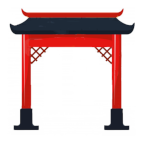| Meaning |

public 公
|
| Explanation |
|
Used in these characters:
|
|
公
|
 |
|
JLPT HSK 2 |
|
| public, collectively owned, common, male (animal)
|
Eight 八, nose 厶 (a nose in side view)
Eight noses stand for the public.

|
|
|
|
松
|
 |
|
JLPT HSK 4 |
|
| loose, to loosen, to relax, pine (=tree)
|
Left: tree 木, right: public 公 (Eight 八 noses 厶 form the public.)
A tree for the public is the pine tree.

|
|
|
|
讼
|
 |
|
JLPT HSK 6 |
|
| litigation, lawsuit, legal dispute/case
|
Left: word 讠/言, right: public 公 (eight 八 noses 厶 form the public.)
Words are publicly disputed: in a litigation.

|
|
|
|
颂
|
 |
|
JLPT HSK 6 |
|
| to praise, ode, bless, eulogy
|
Left: public 公 (Eight 八 noses 厶 form the public.), right: page, leaf, head 页/頁 (head 目 with shoulders 八 and eyebrows 一)
(Think of celebrities:) A public (fore-)head is praised.

|
|
|
|
嗡
|
 |
|
JLPT no HSK |
|
| onomat. buzz (of bees), hum, drone
|
Left: mouth 口, right: elderly man 翁 (Publicly 公 wearing wings 羽 is sth. for elderly men)
(A sound) as if from a mouth gets public by the wings, when: buzzing.

|
|
|
|
翁
|
 |
|
JLPT no HSK |
|
| elderly man, father
|
Top: public 公 (eight 八 noses 厶 form public), below: wings 羽
Publicly wearing wings is sth. for elderly men.

|
|
|
|
瓮
|
 |
|
JLPT no HSK |
|
| earthen jar, pottery container for water/wine, urn
|
Top: public 公 (eight 八 noses 厶 form public), bottom: roof tile 瓦 (image of inter-hooked tiles; here: symbol for earthenware)
It is for the 'eight noses' and earthenware: the jar.

|
|
|
| Radicals are shown here that are similar either in appearance or meaning. |  |
|
At the page you get the memory phrases for learning the Chinese Hanzi. If you are learning the Japanese kanji, please follow this link. |
List of the characters |
List of the radicals
|

